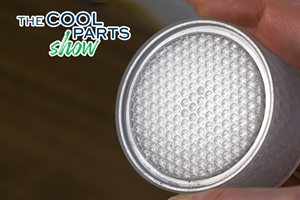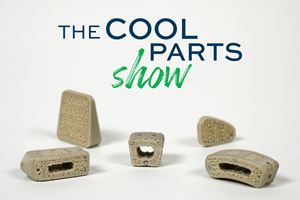3D Systems Developing Regenerative Tissue Program for Surgical Reconstruction
The first product under development targets patient-specific regenerative breast tissue.
3D Systems’ Regenerative Tissue Program is intended to provide a more personalized solution for surgical procedures requiring reconstruction. The company says it is establishing this program as a result of significant progress achieved in developing next-generation bioprinting solutions for 3D printed solid organs. Through the combination of bioprinting technology, biocompatible 3D printing materials and patient-derived cells, the company is constructing vascularized, patient-specific living human tissues.
“The level of innovation we’ve been able to unlock with our solutions for regenerative medicine is allowing us to deliver an unmatched level of complexity and precision,” says Dr. Jeffrey Graves, 3D Systems president and CEO. “We’re proud of the progress we’re making in the development of bioprinting solutions for human organs including lung, liver and kidney. With this as the foundation, combined with the expertise gained through years of experience in the manufacturing of personalized medical implants, we have quickly moved into the development of patient-specific human tissues that can dramatically alter how patient care is delivered.”
Through the power of advanced 3D modeling, novel bioinks and high-speed, high-resolution 3D bioprinters, 3D Systems is developing an acellular biointegrative scaffold to regenerate adipose tissue. This scaffold can be combined with intraoperative cellularization (such as fat grafting) with adipose cells harvested from the patient during surgery. This results in a regenerative scaffold that mimics the patient’s anatomy and physiology to help deliver improved surgical outcomes — thereby addressing the clinical need for a long-term reconstructive solution for soft tissue applications.
The company says it will leverage its VSP surgical planning solutions to plan and design these patient-specific scaffolds to help improve surgical outcomes and elevate the patient experience. As a provider of personalized health care solutions, 3D Systems has worked with surgeons, including reconstructive plastic surgeons, for over a decade to plan more than 150,000 patient-specific cases, and manufacture more than 2 million implants and instruments for 100-plus CE-marked and FDA-cleared devices. Leveraging VSP for its tissue program, 3D Systems’ biomedical engineers will be able to collaborate with surgeons — beginning with the patient’s digital data — to design and manufacture biointegrative scaffolds to match the patient’s anatomy.
According to the company, the first product under development targets patient-specific regenerative breast tissue (RBT), offering a a patient-specific reconstructive solution for breast cancer survivors. According to the World Health Organization, 2.3 million women were diagnosed with breast cancer globally in 2020, and the five-year survival post-diagnosis has increased to more than 90% in high-income countries. With the increased survival rate, there is a growing need for long-term regenerative solutions for breast reconstruction. Current options for reconstruction after mastectomy include implant-based reconstruction (for example, inserting a silicone/saline implant) and autologous flaps (such as harvesting live tissue from the patient). Both are prone to postsurgical complications and often require additional procedures.
Over the past 12 months, 3D Systems says it has conducted in-depth research that is guiding its efforts into building a platform for tissue regeneration. This includes completing multiple large animal studies demonstrating a proof-of-concept for biointegrative scaffolds for adipose tissue regeneration. In particular, the company is investigating host-mediated engraftment of a passively-implanted angiogenic scaffold to explore the ability to grow new blood vessels. Additionally, they have demonstrated the ability for direct vascular connection of an anastomosed (for example, connecting directly to the vasculature) scaffold. The scaffolds are constructed at the human scale from a family of biocompatible materials with tunable material properties which the company believes will be able to address and personalize human breast-size tissue reconstructions.
“Through the Regenerative Tissue Program, we now have a unique, vertically integrated technology platform that enables us to produce detailed hydrogel scaffolds for multiple soft tissue applications,” says Katie Weimer, 3D Systems vice president, regenerative medicine. “Our ability to 3D print high-resolution and large-volume biointegrative, vascularized tissue sets us apart and opens tremendous opportunities in providing a unique solution to breast reconstruction surgeons and patients. I’m inspired by the potential of RBT as our first tissue application, and believe this work will be expanded into future applications such as lumpectomies, breast augmentation and facial implants.”
- Learn about 3D Systems latest production-grade materials designed to address a breadth of industrial applications.
- Read about 3D Systems partnership with Ems-Griltech to produce DuraForm PAx Natural, a material available for all selective laser sintering platforms.
Related Content
Ultra-Complex 3D Printed Scaffolds Enable Cell Growth: The Cool Parts Show #70
Perhaps the ultimate surface-area challenge is in bioengineering: creating structures that can grow sufficient cells within a compact volume to be effective for leading-edge medical treatments. The Southwest Research Institute develops bioreactor scaffolds that could only be made using 3D printing.
Read MoreFDA-Approved Spine Implant Made with PEEK: The Cool Parts Show #63
Curiteva now manufactures these cervical spine implants using an unusual 3D printing method: fused strand deposition. Learn how the process works and why it’s a good pairing with PEEK in this episode of The Cool Parts Show.
Read MoreOvercoming Challenges with 3D Printing Nitinol (and Other Oxygen-Sensitive Alloys) Through Atmospheric Control
3D printed nitinol has potential applications in dental, medical and more but oxygen pickup can make this material challenging to process. Linde shares how atmospheric monitoring and the use of special gas mixtures can help maintain the correct atmosphere for printing this shape alloy and other metals.
Read MoreQ&A With Align EVP: Why the Invisalign Manufacturer Acquired Cubicure, and the Future of Personalized Orthodontics
Align Technology produces nearly 1 million unique aligner parts per day. Its acquisition of technology supplier Cubicure in January supports demand for 3D printed tooling and direct printed orthodontic devices at mass scale.
Read MoreRead Next
Profilometry-Based Indentation Plastometry (PIP) as an Alternative to Standard Tensile Testing
UK-based Plastometrex offers a benchtop testing device utilizing PIP to quickly and easily analyze the yield strength, tensile strength and uniform elongation of samples and even printed parts. The solution is particularly useful for additive manufacturing.
Read MoreAlquist 3D Looks Toward a Carbon-Sequestering Future with 3D Printed Infrastructure
The Colorado startup aims to reduce the carbon footprint of new buildings, homes and city infrastructure with robotic 3D printing and a specialized geopolymer material.
Read MorePostprocessing Steps and Costs for Metal 3D Printing
When your metal part is done 3D printing, you just pull it out of the machine and start using it, right? Not exactly.
Read More




















